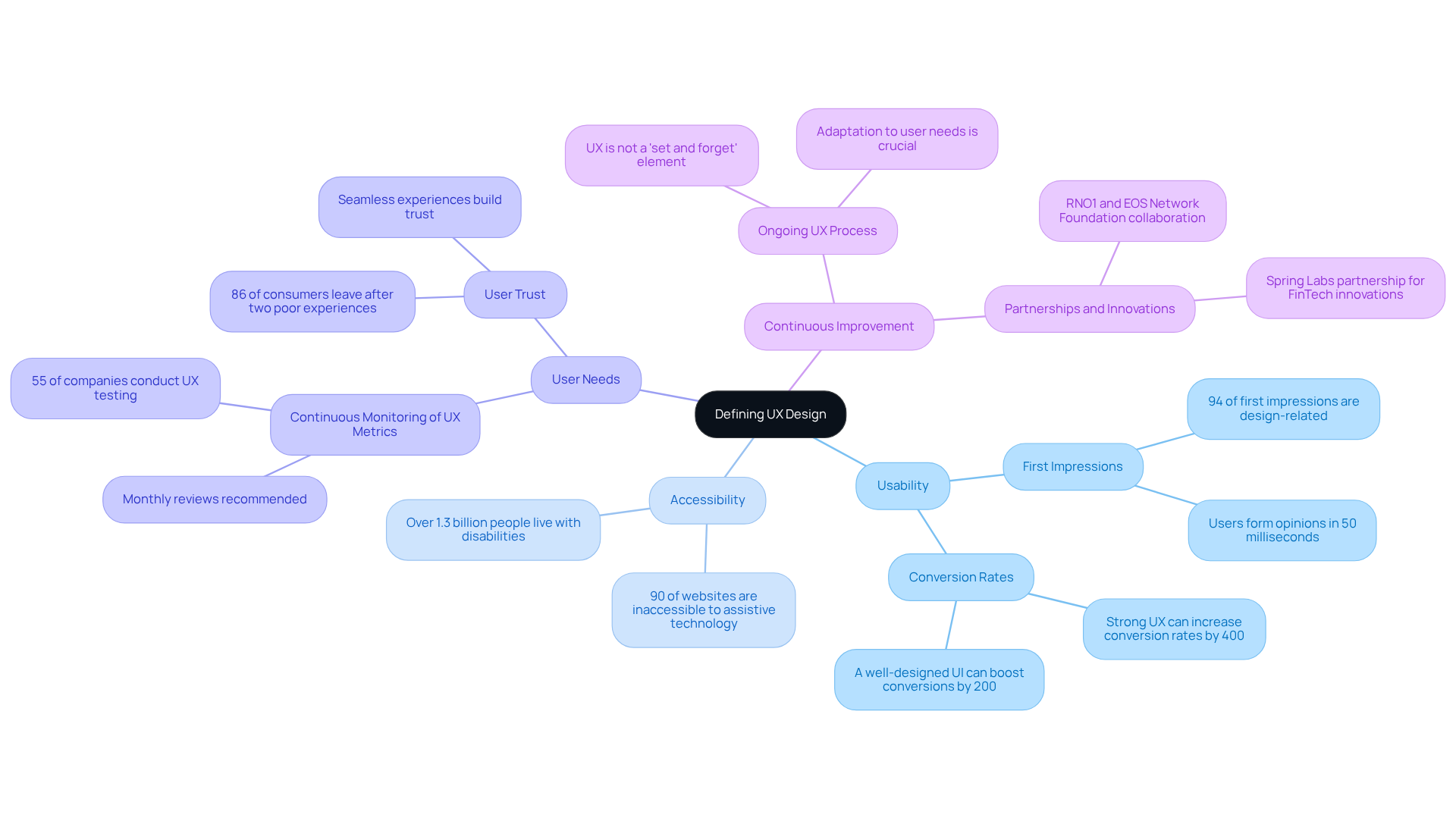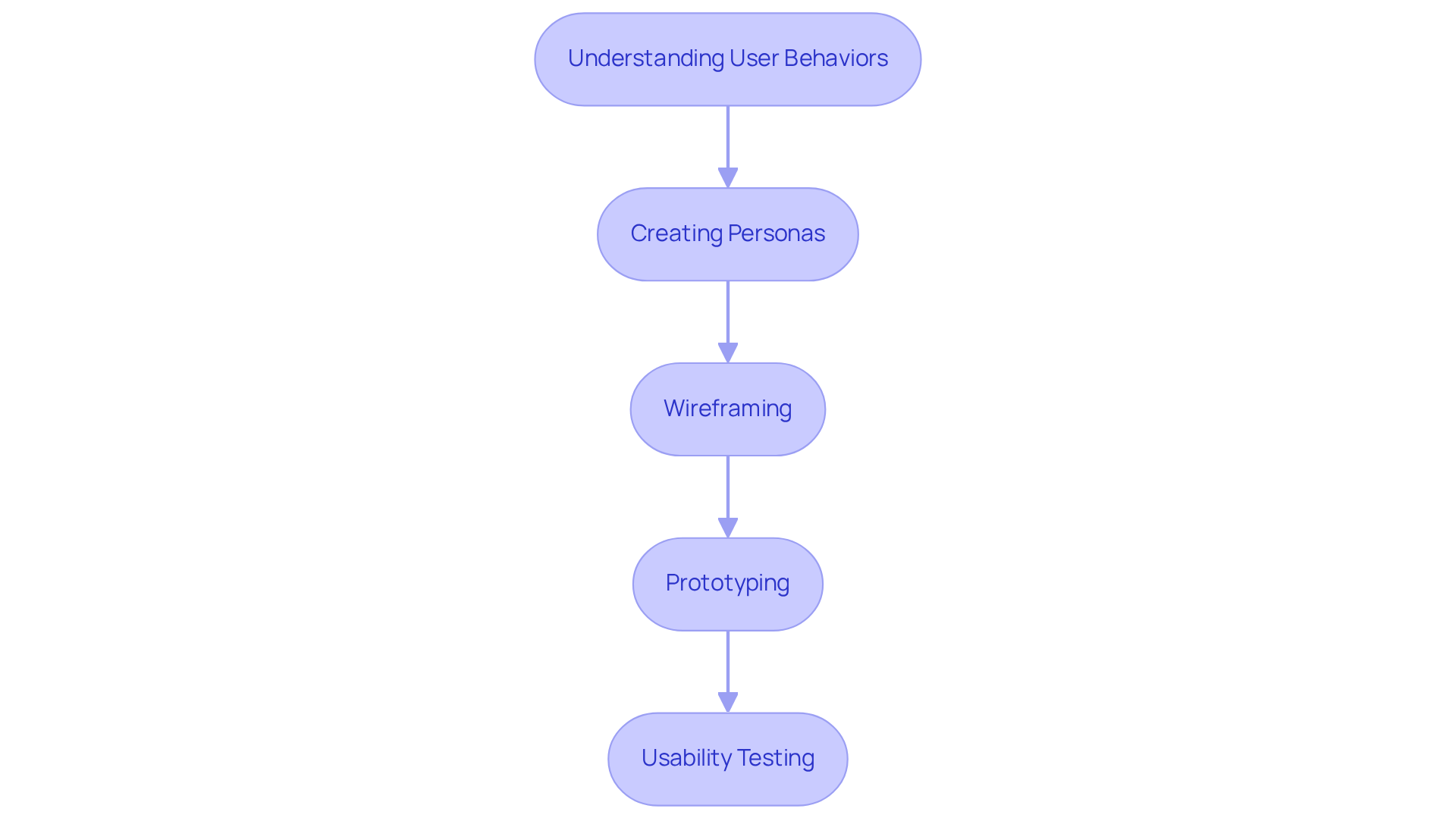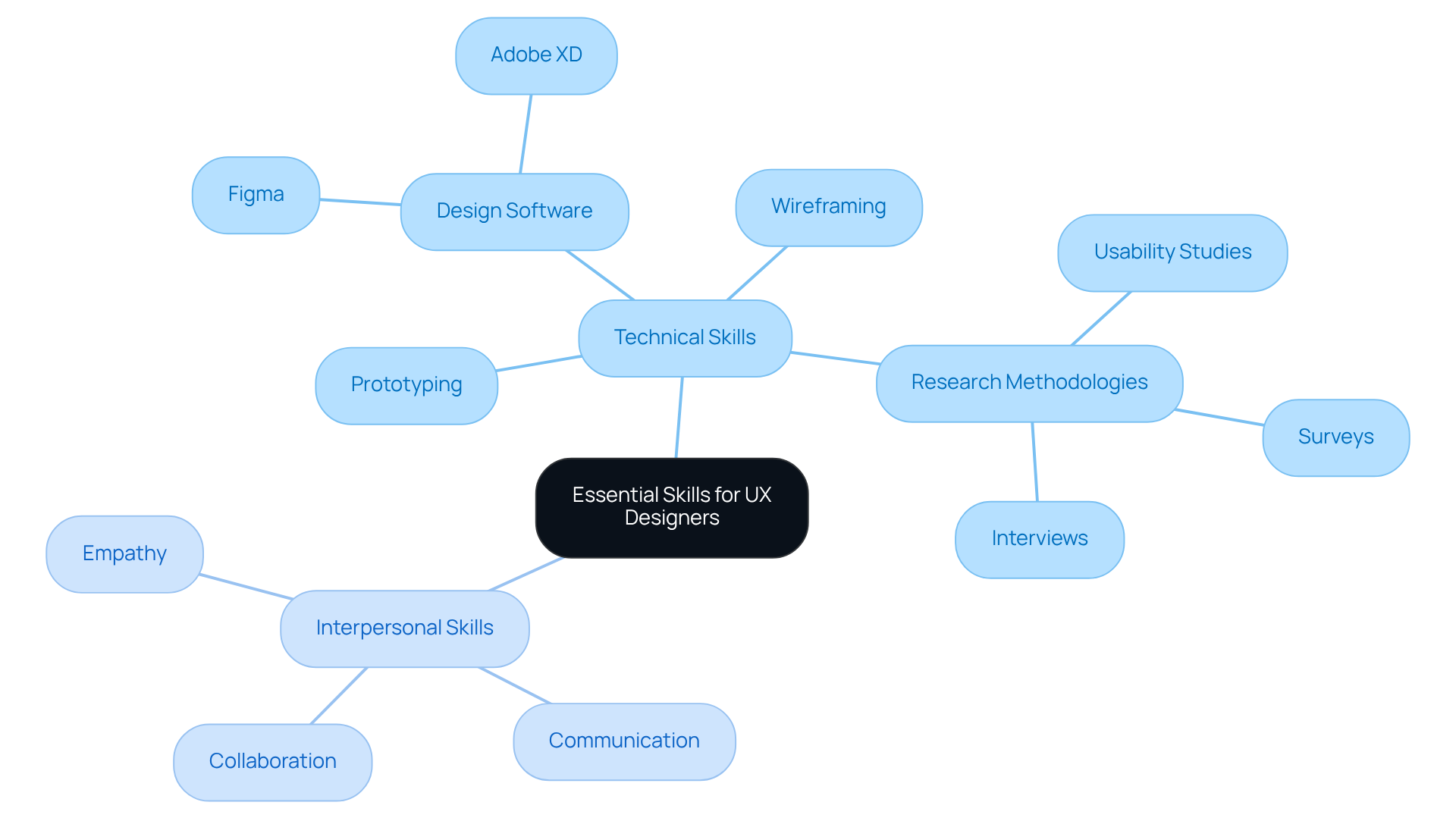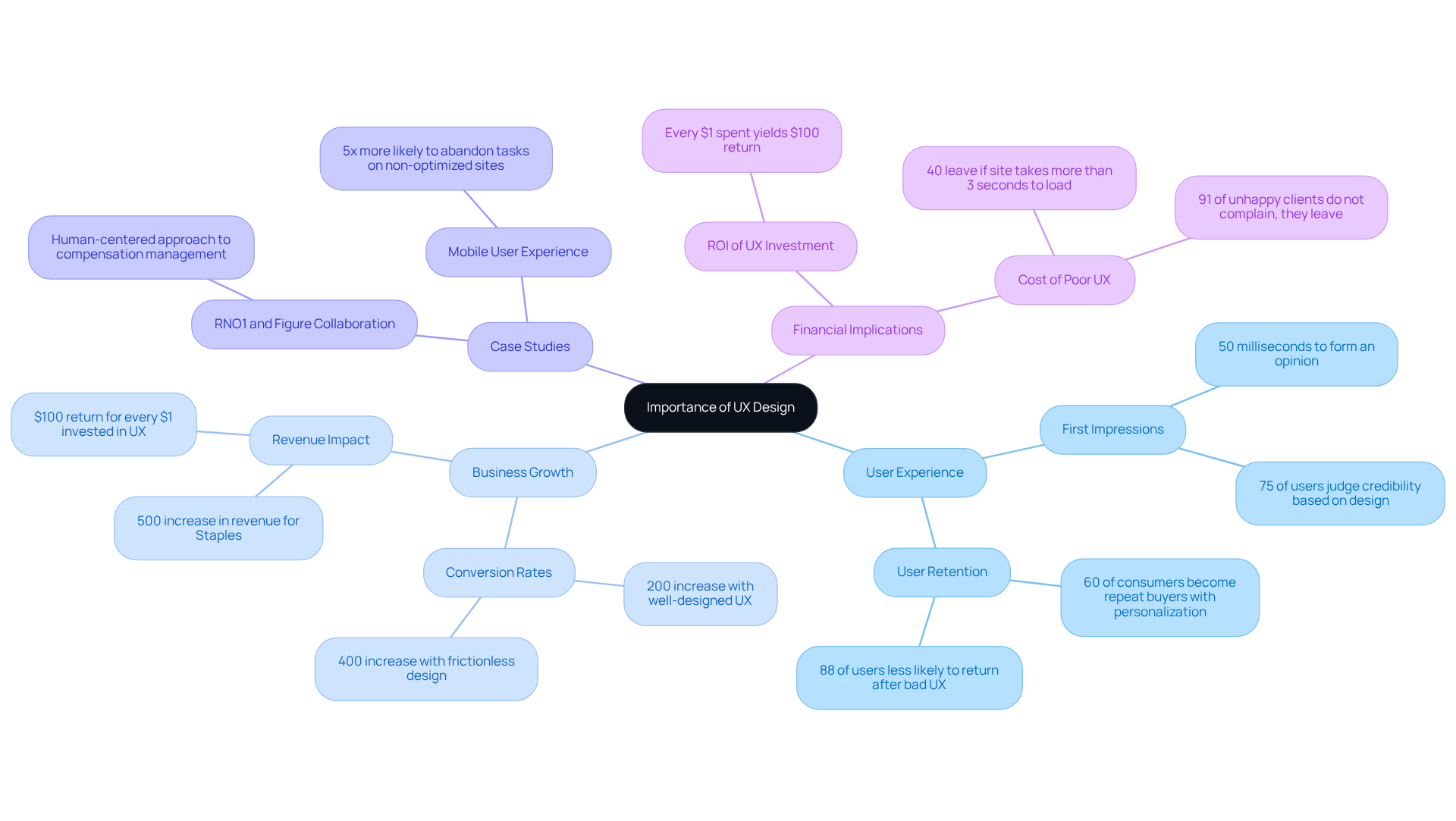Overview
A UX designer plays a vital role in enhancing user interactions with digital products, focusing on understanding user needs, usability, and accessibility. Many tech startup founders face the challenge of creating products that resonate with their audience. When users struggle to navigate or connect with a product, it can lead to frustration and disengagement. This not only impacts customer satisfaction but can hinder business growth as well.
Statistics reveal that when user-centered design principles are applied, companies experience significant increases in conversion rates and customer retention. This highlights the importance of effective UX design in fostering positive user experiences. By prioritizing the needs of users, startups can create solutions that truly resonate, driving both satisfaction and loyalty.
Embracing these principles can transform the way users interact with your product, ultimately leading to a thriving business. Remember, nurturing these connections is key to success in the digital landscape.
Introduction
In today's fast-paced digital world, understanding the role of a UX designer is more important than ever. User interactions can truly make or break a brand's success, and many founders feel the weight of this responsibility. This article explores the multifaceted responsibilities and essential skills that define effective UX design, emphasizing how a user-centered approach not only enhances customer satisfaction but also drives significant business growth. Yet, as technologies evolve and consumer expectations shift, UX designers face unique challenges in creating seamless experiences.
What does this mean for you as a founder? It highlights the intricate balance between technical proficiency and interpersonal skills that are vital for thriving in this dynamic field. Together, we can navigate these complexities and foster a supportive environment for your growth.
Defining UX Design: Core Concepts and Principles
User Experience (UX) creation fundamentally addresses what is UX designer by focusing on enhancing the interactions between individuals and digital products. This vital discipline encompasses essential elements such as usability, accessibility, and the overall enjoyment derived from these interactions. At its core, what is ux designer effective UX is rooted in a deep understanding of individual needs, the crafting of intuitive interfaces, and the delivery of a seamless, enjoyable experience.
Yet, many founders face the challenge of navigating the complexities of UX in an ever-evolving digital landscape. As technology advances and consumer expectations shift, the stakes become higher. Research reveals that 94% of first impressions are design-related, with users forming opinions about a website in merely 50 milliseconds. This underscores the necessity for creators to prioritize user-focused approaches in their projects, ensuring that every interaction counts.
RNO1 exemplifies this commitment through transformative partnerships, such as their collaboration with the EOS Network Foundation to redefine online branding and customer interaction. This initiative fosters innovation within the EOS Network, illustrating how a human-centered approach can lead to meaningful advancements. Additionally, their partnership with Spring Labs, a VC-supported FinTech startup, showcases RNO1's dedication to creating forward-thinking technological interactions across diverse engagement points.
Thought leaders in the field emphasize the importance of this approach. As Jesse James Garrett insightfully stated, "The individual's interaction is not a single facet of the creation—it is the creation." This perspective highlights that understanding what is ux designer is essential to the effective creation of digital products and their overall success. Daniel Kodam further reinforces this notion, asserting that understanding what is ux designer is essential, as UX/UI serves as the backbone of a robust application, emphasizing the crucial role of the end-user's interaction in product development.
Statistics further illustrate the impact of UX design on customer satisfaction. A strong UX can lead to conversion rates soaring by as much as 400%, while poor interactions can result in significant losses—up to 35% of sales may be forfeited due to ineffective UX. Moreover, 88% of individuals are less likely to revisit a website after experiencing a negative encounter. Successful UX design projects often prioritize usability and accessibility, ensuring that products cater to a diverse audience, including individuals with disabilities. By focusing on these elements, companies can enhance customer satisfaction and nurture long-term client loyalty.
It's important to remember that UX is not a one-time effort; it should be viewed as a continuous process. As Frosina Stojchevska emphasizes, ongoing enhancement and adaptation to the needs of individuals are crucial. By embracing this mindset, founders can create not just products, but experiences that resonate deeply with users, fostering a sense of community and support in the digital realm.

Key Responsibilities of a UX Designer: From Research to Prototyping
UX designers face the challenge of creating effective digital interactions, a task that requires a deep understanding of user behaviors and preferences. This understanding is crucial for guiding their creation strategies. As we look toward 2025, it's clear that current trends in participant research methodologies highlight the importance of advanced analytics and AI tools. These tools enhance the depth of insights, allowing designers to tailor experiences more precisely to meet user needs. A significant part of their work involves crafting personas that represent target audiences, guiding design choices. Successful client persona development is rooted in thorough research and collaboration, ensuring that these personas genuinely reflect the needs and motivations of real individuals.
Moreover, UX designers create wireframes and prototypes to illustrate interfaces, enabling early feedback and iterative enhancements. This process is vital; usability testing allows designers to assess the effectiveness of their designs, making necessary modifications based on user feedback. Such an iterative approach not only improves user satisfaction but also ensures that the final product aligns with expectations. In 2025, optimal research approaches involve engaging diverse groups and utilizing a blend of qualitative and quantitative techniques to gain a comprehensive understanding of user experiences.
By embracing these practices, UX professionals can create solutions that are not only functional but also resonate deeply with individuals, fostering engagement and loyalty. Together, let's support the journey of UX designers and understand what is a UX designer as they strive to connect with users on a meaningful level.

Essential Skills for UX Designers: Balancing Technical and Interpersonal Abilities
To thrive in the ever-evolving realm of UX, it's essential for professionals to understand what is a UX designer and nurture a balance of technical and interpersonal skills. The challenge lies in mastering design software like Figma and Adobe XD, alongside wireframing, prototyping, and research methodologies. This skill set is increasingly vital, as the U.S. Bureau of Labor Statistics forecasts a 16% growth rate for web developers and digital designers, highlighting the rising demand for those who know what is a UX designer. Consider this: 53% of mobile site visitors abandon a page that takes more than three seconds to load. This statistic underscores the critical role that technical skills play in retaining visitors and enhancing user satisfaction.
On the interpersonal side, qualities such as empathy, communication, and collaboration are indispensable. Empathy allows designers to deeply understand client needs, fostering a connection that resonates. Effective communication and teamwork facilitate smooth interactions within cross-functional teams. As Sharon Hoffman wisely noted, "Individuals base 75% of their assessment of a website’s credibility solely on its appearance." This insight emphasizes how interpersonal skills are crucial in creating engaging and trustworthy user experiences. Furthermore, a staggering 88% of internet shoppers indicate they would not return to a site after a negative interaction, highlighting the necessity of these skills in customer retention.
Striking a balance between these technical and interpersonal abilities is vital for understanding what is a UX designer and crafting user-centered solutions that resonate with target audiences while ensuring seamless project execution. This dual focus not only enhances client interactions but also contributes to the overall success of digital products. By embracing both aspects, we can foster a nurturing environment that promotes collaboration and innovation, ultimately leading to more meaningful connections with users.

The Importance of UX Design: Enhancing User Experience and Driving Business Growth
In today's digital landscape, many businesses struggle with creating user experiences, which raises the question of what is UX designer that can truly resonate with their customers. This challenge can lead to frustration and missed opportunities for growth. Companies that overlook the importance of UX often find themselves facing dwindling customer loyalty and lower conversion rates, which can be disheartening. Yet, there is hope. By prioritizing UX, businesses can unlock a pathway to not only satisfy their users but also to foster long-lasting relationships.
Take, for instance, RNO1's impactful collaborations, such as the one with Figure. Their human-centered approach to compensation management has not only transformed the experience for users but has also set a benchmark for modern HR platforms. It’s a testament to how effective UX can drive success. Research supports this notion, revealing that a well-designed interface can boost conversion rates by as much as 200%. Imagine the potential of a frictionless UX design, which could elevate those rates by up to 400%, according to Forrester Research.
Moreover, the financial implications are staggering. For every $1 invested in UX, businesses see a return of $100. This highlights the immense value of investing in customer interaction. By crafting intuitive and enjoyable experiences, companies can reduce support costs and enhance engagement, leading to greater profitability. As the digital environment continues to evolve, understanding what is UX designer will become increasingly significant, making it a vital focus for organizations striving for success.
Consider the case of Staples, which experienced a remarkable 500% increase in online revenue after a UX-focused site redesign. This underscores the tangible benefits of prioritizing user experience. In a competitive market, delivering exceptional UX is not merely a bonus; it is essential for sustainable growth. Together, let’s embrace the journey towards creating better user experiences, fostering a community where every interaction counts.

Conclusion
User Experience (UX) design is not just a technical requirement; it is a vital aspect of how individuals connect with digital products. Many businesses struggle to engage users effectively, leading to frustration and lost opportunities. This highlights the importance of adopting a user-centered approach that prioritizes usability and enjoyment. Understanding the role of a UX designer, along with their responsibilities and skills, is essential for businesses that wish to thrive in a competitive digital landscape. By focusing on creating intuitive interfaces and seamless interactions, organizations can significantly enhance user satisfaction and foster long-term loyalty.
Throughout this journey, we uncover the multifaceted nature of UX design. From thorough user research and persona development to the continuous improvement prompted by user feedback, each element plays a crucial role. The balance between technical proficiency and interpersonal skills is vital for UX designers, allowing them to craft engaging and effective digital experiences. The statistics speak volumes, demonstrating the tangible benefits of investing in UX—showing how a strong user experience can lead to substantial increases in conversion rates and overall business growth.
As we navigate this ever-evolving digital environment, the significance of UX design becomes increasingly clear. Businesses must embrace these principles to cultivate meaningful connections with users, creating a community where every interaction is cherished. By prioritizing user experience, organizations not only enhance their brand reputation but also unlock the potential for sustainable growth and success in this dynamic landscape. Together, let us champion the cause of user experience, ensuring that every user feels valued and understood.
Frequently Asked Questions
What is UX design?
UX design focuses on enhancing the interactions between individuals and digital products, emphasizing usability, accessibility, and overall enjoyment derived from these interactions.
Why is understanding user needs important in UX design?
A deep understanding of individual needs is crucial for crafting intuitive interfaces and delivering a seamless, enjoyable experience, which is essential for effective UX.
What challenges do founders face regarding UX design?
Founders often struggle with navigating the complexities of UX in a rapidly evolving digital landscape, where technology advances and consumer expectations shift.
How significant is design in forming first impressions?
Research shows that 94% of first impressions are design-related, with users forming opinions about a website in just 50 milliseconds, highlighting the importance of user-focused design.
Can you provide examples of successful UX partnerships?
RNO1 has partnered with the EOS Network Foundation to redefine online branding and customer interaction, and with Spring Labs, a FinTech startup, to create innovative technological interactions.
What do thought leaders say about the importance of UX design?
Thought leaders like Jesse James Garrett emphasize that individual interactions are central to the creation of digital products, while Daniel Kodam stresses that UX/UI is the backbone of robust applications.
How does UX design impact customer satisfaction and conversion rates?
A strong UX can increase conversion rates by up to 400%, while poor UX can lead to significant losses, with up to 35% of sales potentially lost due to ineffective UX.
What are the consequences of negative UX experiences?
88% of individuals are less likely to revisit a website after a negative encounter, underscoring the importance of positive UX.
How should companies approach UX design?
Successful UX design projects prioritize usability and accessibility to cater to a diverse audience, including individuals with disabilities, enhancing customer satisfaction and loyalty.
Is UX design a one-time effort?
No, UX design should be viewed as a continuous process, with ongoing enhancements and adaptations to meet the evolving needs of users.




